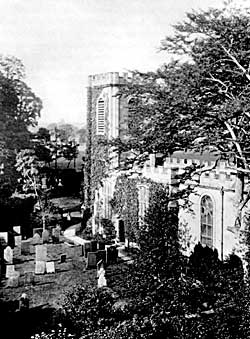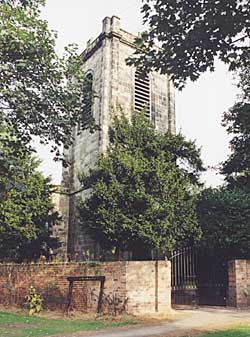
Colwick Church.
On the other side of the chancel is a ponderous marble monument with two life-sized figures with cherubs, skulls, and other emblems of death, to John Musters, who married the Mundy heiress. He predeceased his father by a few years, and died at the early age of thirty-seven. On the monument may be seen a shield of arms, showing Musters, viz.:—Argent, on a bend gules a lion passant guardant or, a bordure engrailed of the second, impaling those of Mundy. This monument was erected by his widow, who lived to the age of eighty-six years.
On the north wall may be seen a tablet, which is plain in comparison to the sumptuous mementos that have already been referred to, to John Musters, of Colwick (only son of Mundy Musters), who died in 1827, aged seventy-four, and to his only son, another John, of Colwick, Annesley, and Wiverton, who died in 1849, aged seventy-three, having married the heiress, Mary Chaworth. The first John Musters on this tablet was the husband of Mrs. Sophia Catherine Musters, the talented painter of the east window ; she was the daughter and co-heir of James Modyford Heywood, from Devonshire, and is represented by the graceful seated figure, typical of resignation, sculptured in white marble by Westmacott, at the south side of the altar with three medallions on the pedestal, representative of her accomplishments, viz., painting, dancing, and music.
The next in point of interest among this interesting collection of monuments is the life-sized figure, in white marble, at the north side of the altar, representing Mary Ann Musters, the Chaworth heiress, who brought the Annesley, Edwalton, and Wiverton estates to the Musters family by her marriage with the John Musters referred to on the plain double tablet on the north wall. She is known to us as “Byron’s Mary,” and the poet’s attachment to her is familiar to all Nottinghamshire folk, in the verses he wrote about her, as also is her sad death, which resulted from exposure to the pouring rain whilst hiding in the shrubberies when the mob of rioters, on 10th October, 1831, attacked the hall, plundering and setting fire to its valuable contents; from this fright she never recovered, and died at Wiverton, four months afterwards, on 6th February, 1832, aged forty-seven. Her husband adopted the name of Chaworth, but subsequently resumed the name of Musters; it is said that he might have been raised to the peerage, with the title of Lord Chaworth of Annesley, but he refused, thinking he had not sufficient means to support the position.
The issue of this marriage was a son, John George Chaworth Musters, to whom there is a plain tablet on the north wall; he predeceased his father on 2nd August, 1842, aged thirty-four years. He married a Miss Hamond, of Westacre, Norfolk, by whom he left three children, John Chaworth Musters, George Chaworth Musters, and Mary Ann Chaworth Musters; the elder of the sons succeeded to the estates when aged eleven, and, no doubt, is well remembered by many still living as “Squire Musters,” the master of the Quorn and South Notts. Hounds. He married the elder daughter of the late Mr. Henry Sherbrooke, of Oxton, and their son, John Patricius Chaworth Musters, who was born in 1860, is now squire of Annesley.

The church of St John the Baptist, Colwick, is now a roofless ruin (A. Nicholson ©2002). The monuments have all been transferred to Newstead Abbey.
A paper on the monuments at Colwick Church would not be complete without drawing attention to two 17th century floor-stones near the font to members of the Clarkeson family; there is also a cluster of head-stones to other members of the same family in the churchyard; the chief notoriety attaching to this family is that one of the members was the originator of the far-famed Colwick cheese. Under the churchyard wall, on the sunless north side of the church, are the graves in which lie the bodies of Mrs. Saville and her three children, who were cruelly murdered in Colwick Wood, on 21st May, 1844, by William Saville, who was very deservedly hung on the steps of the Shire Hall, on 8th August following: several people were trampled to death in the crowd that thronged to see this morbid spectacle.
There is a crossing over the Midland and Great Northern railways still known as “Saville’s crossing.”
The various owners of the Colwick estate and its attractive hall and surroundings little foresaw that the day would come when a racecourse would be laid out close to their front door, when an electric tramway would carry them to their park gates, and a steamboat to the river entrance to the grounds, and their stately hall would be licensed as an hotel—but so it is to-day.
It is difficult to write a paper and keep distinct the various owners where the Christian name of John is so persistently adhered to as was the case in the owners of Colwick. There were six John Byrons in succession, and the Musters family adhered to the name with a very similar persistency.
In conclusion, I have to acknowledge the kind assistance Mr. F. W. Dobson has afforded me in compiling this paper, together with the co-operation of Mr. Harry Gill.
After an examination of the various points of interest at the church, the party made their way to the hall, which is adjacent, and is now licensed as an hotel, and there had tea in one of the spacious rooms of this fine house, where the evidences of its former grandeur are still to be seen.
(1) The words in italics are the only words now decipherable. January, 1916 —G F
